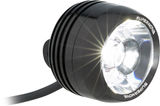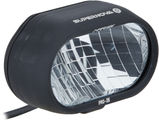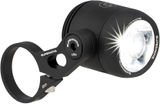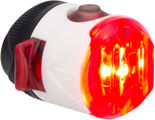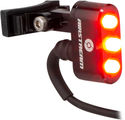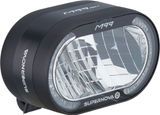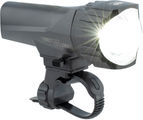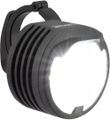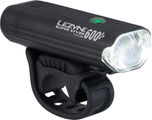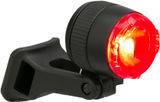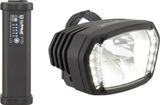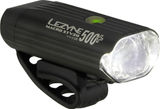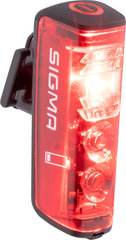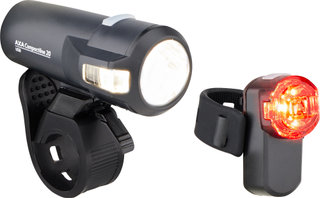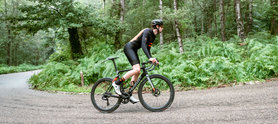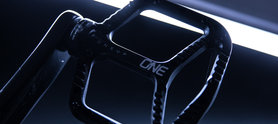Bicycle Lights - Battery
OUR Bicycle Lights - Battery RECOMMANDATIONS
Our Suggestions
Battery or dynamo? It’s your call
If you want to be prepared for dark rides at all times, then you ought to consider dynamo lighting. If you rarely ride with lights, don’t want to spend much on them, want to maintain a low weight or if you want a more portable solution, then modern battery-powered lighting is an ideal choice.
The legal status of battery-powered lighting in Germany
Note: StVZO regulations apply only in Germany and do not apply elsewhere. Please consult with your local municipality for information regarding public safety regulations.
Since German regulations changed in 2017, rechargeable and disposable battery-operated lighting systems are approved for use on bicycles, regardless of type or weight. All lighting must meet the requirements of German Road Traffic Licensing Regulations, otherwise it may not be used on public streets. A product’s conformity with these regulations is indicated by a K-mark (for Kraftfahrt-Bundesamt): a wavy line, the capital letter K and a number. (We also indicate StVZO conformity in our own product descriptions.) Since the rule change, our product offerings have increased substantially, ranging from simple emergency lights (e.g. Sigma Micro Duo LED) to high-end headlamps with high output, large batteries and various additional features, such as the world's brightest battery-powered headlamp with StVZO approval, the Supernova M99 Mini PRO B54. Speaking of the law: The use of flashing lights on bikes is not permitted, but they can be worn on the body. Many everyday helmets, such as the ABUS Pedelec 2.0, are therefore equipped with integrated rear lights. Plug-in lights can be retrofitted for use on other helmet models.
The faster you ride, the more light you’ll need
If you have a more aggressive riding style, travel frequently at high speeds or across extreme terrain, your front light requires as much power as possible to meet these demands. Light output is specified either in lux or lumens. Lumen is the international unit (SI) for luminous flux and indicates how much light a lamp emits at a given time. Lux is the SI unit for luminosity and indicates the amount of incident lighton a surface.
There’s just a simple rule of thumb in this case: more is more! Whether your light has values over 100 lux (e.g. Busch + Müller Ixon Space LED) or over 200 lumens (e.g. Lezyne Lite Drive Pro 115 LED), you’re already playing in the big leagues. Front lights such as the SL AF 7 LED by Lupine transform night into day, and can certainly hold their own against car headlights in terms of brightness. Be aware, however, that values are not directly comparable and cannot be easily converted between one another.
Tip: If you plan on mountain biking across technically demanding terrain in the dark, a powerful helmet lamp is the best option. Its light cone is directed exactly along your line of vision, whereas the light cone of a handlebar light corresponds to steering movements. Having only the latter option makes it difficult to see oncoming turns on winding trails, so we recommend a combination of both lights for optimum perspective.
Lights for daily cycling
If you’re a daily cyclist who mainly rides on city streets and in traffic, you do not necessarily need a lot of light. Low power consumption, quick installation and practical features, such as a USB rechargeable battery, are more important than maximum performance. Front lights that conform to German Road Traffic Licensing Regulations (StVZO) begin at 10 lux and upwards, so lights ranging between 20 and 50 lux are great for everyday cyclists. Some front lights such as the Sigma Aura 60 USB LED have extra cut-outs to cast light in a sideways direction. The Knog Lil’ Cobber or Mid Cobber emits red light at a 330-degree angle. This allows you to maintain visibility in the front, rear and to the side of the bike.
Rechargeable or disposable batteries?
In a nutshell, the decision is up to you. For compact emergency lights, button cells are often installed to accommodate small spaces. Bigger lights are typically powered by standard AA or AAA batteries. Replacements can usually be purchased from your local supermarket, and dead batteries can be easily swapped out for fresh ones. The convenience of this system, however, generates quite a bit of waste. In this respect, models with rechargeable battery technology offer much better performance. Most rechargeable models contain lithium-ion batteries (Li-Ion), whereas lithium-polymer batteries (Li-Po) are a relatively recent option. Older nickel-metal hydride batteries are being gradually phased out of the market.
If battery life is low, the front or rear light can be easily unplugged and charged at home or at your desk at work. USB charging is particularly convenient, and no special charger is required.
Battery capacity and lighting duration
How long your light lasts depends a lot on how you use it. If you only use your light on dark paths at a lower power setting, it can sit happily on your bike for weeks without issue. If you’re a frequent night rider who requires a lot of power, you’ll need to charge or check the battery state more frequently. Such a difference can be huge, especially with bright lamps like the Busch + Müller Ixon Space, which provides two hours of continuous light at maximum output but a whopping 30 hours in low power mode. It’s also worth mentioning that both rechargeable and non-rechargeable batteries last longer in rear lights than in front lights. Because we here at bc are sticklers for details, we make sure to provide you with the manufacturers’ information regarding the average burn time from a single battery charge. Be aware, however, your mileage may vary due to various environmental factors (e.g. temperature) that can affect battery life.
Tip: Batteries should always be charged at room temperature! Long tours are better when main or spare batteries are charged before the trip begins.
Mounting
In general, front lights are mounted on the handlebars or stem. More importantly, it is essential that the light has a suitable mount fitted to the diameter of either of those parts. Mounts usually work with clamps, tensioning mechanisms or rubber rings. However, there are also great systems that integrate parts from different manufacturers. The TwinFix system, for example, allows the direct mounting of certain Lupine lights on Syntace stems. People who already have a mount for an action cam can also attach certain Sigma lights to it. For rear lights, the seatpost/clamp, seat stay, mudguard and luggage rack are all great mounting options. Our handy search filters can assist you in finding lights based on where you intend on mounting them.
No matter where you install your lights, make sure that they won’t be hindered by cables, guides or other parts and that the front headlight does not shine too brightly in oncoming traffic.
Individual lights or a set?
Sets are usually cheaper than buying front and rear lights separately. Whether or not this is a bargain doesn’t really depend on the price, but rather on if the combination suits your needs. Of course, there is nothing to be said against combining front and rear lamps from different manufacturers.

